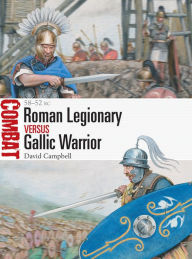[PDF] Roman Legionary vs Gallic Warrior: 58-52 BC by David Campbell, Raffaele Ruggeri
Roman Legionary vs Gallic Warrior: 58-52 BC. David Campbell, Raffaele Ruggeri

Roman-Legionary-vs-Gallic.pdf
ISBN: 9781472844248 | 80 pages | 2 Mb

- Roman Legionary vs Gallic Warrior: 58-52 BC
- David Campbell, Raffaele Ruggeri
- Page: 80
- Format: pdf, ePub, fb2, mobi
- ISBN: 9781472844248
- Publisher: Bloomsbury USA
Downloading ebooks free Roman Legionary vs Gallic Warrior: 58-52 BC in English
Caesar's war machine clashes with the fearsome tribes of Gaul, forever changing the character of the region and laying the groundwork for the rise of the Roman Empire. In the manner of many Roman generals, Caesar would write his domestic political ambitions in the blood and treasure of foreign lands. His governorship of Cisalpine Gaul gave him the opportunity to demonstrate the greatness of his character to the people of Rome through the subjugation of those outside Rome's borders. The fact that the main account of the subsequent wars in Gaul was written by Caesar himself – by far the most detailed history of the subject, with new reports issued annually for the eager audience at home –is no accident. The Roman Army of the late Republic had long been in the process of structural and change, moving towards the all-volunteer permanent standing force that would for centuries be the bulwark of the coming Empire. Well-armed and armored, this professional army was trained to operate within self-supporting legions, with auxiliaries employed in roles the legions lacked such as light troops or cavalry. The Roman legions were in many ways a modern force, with formations designed around tactical goals and held together by discipline, training and common purpose. The armies fielded by the tribes of Gaul were for the most part lightly armed and armored, with fine cavalry and a well-deserved reputation for ferocity. As might be expected from a region made up of different tribes with a range of needs and interests, there was no consensus on how to make war, though when large armies were gathered it was usually with the express purpose of bringing the enemy to heel in a pitched battle. For most Gauls – and certainly the military elites of the tribes – battle was an opportunity to prove their personal courage and skill, raising their status in the eyes of friends and foes alike. Fully illustrated, this study investigates the Roman and Gallic forces pitched into combat in three battles: Bibracte (58 BC), Sabis (57 BC) and Gergovia/Alesia (52 BC). Although charismatic Gallic leaders did rise up – notably Dumnorix of the Aedui and later Vercingetorix of the Arverni – and proved to be men capable of bringing together forces that had the prospect of checking Caesar's ambitions in the bloodiest of ways, it would not be enough. For Caesar his war against the Gauls provided him with enormous power and the springboard he needed to make Rome his own, though his many domestic enemies would ensure that he did not long enjoy his success.
Roman Legionary vs Gallic Warrior: 58–52 BC (Combat) (Paperback
Roman Legionary vs Gallic Warrior by David - Rewardia
Roman Legionary vs Gallic Warrior: 58–52 BC (Combat
Raffaele Ruggeri - History: Books - Amazon.com
New Releases in Ancient Military History - Amazon.com
Roman Legionary vs Gallic Warrior by David Campbell
Roman Legionary vs Gallic Warrior on Apple Books
The Italian Invasion of Abyssinia 1935–36: David Nicolle
Amazon.co.jp: Raffaele Ruggeri: Foreign Language Books
Roman Legionary vs Gallic Warrior - Osprey Publishing
Other ebooks:
[PDF] Polysecure: Attachment, Trauma and Consensual Nonmonogamy by Jessica Fern, Eve Rickert, Nora Samaran
Online Read Ebook Meet Cute Diary
[PDF] The Official Ninja Foodi Grill Cookbook for Beginners: 75 Recipes for Indoor Grilling and Air Frying Perfection by Kenzie Swanhart
0コメント